

Oldest testimonies of direct sunlight
reaching the Earth’s surface are recent,
probably not more than 7'000 years
ago.
Those testimonies coincide with the present
Geological period of nearly
constant sea-level, which I suggest to name
Heliocene.
Here is the graph of
the
Variations of
Post-glacial Sea-level, in
meters
vs.
Time Before Present, in
thousand of years.
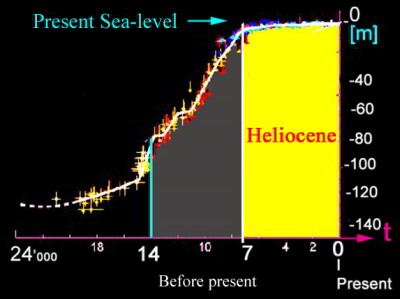
This recent data compilation is the achievement of Robert
A. Rohde
http://commons.wikimedia.org/wiki/File:Post-Glacial_Sea_Level.png
It led me to suggest that the lull of those
last 7000 years might have
cleared the sky and allowed homo sapiens to herald
the Sun.
In contrast,
during
the period
between 14 to 7 thousand years Before Present
occurred a breath-taking fast rise of the sea level at
a
rate of 15 mm
per annum, surely a source of
deep mental frustration
for the inhabitants near sea shore.
Such a rise has not only drown the Cosquer cave,
cut off the British
islands from continental Europe by flooding Doggerland,
but also, I suspect,
generated permanent overcast skies.
The lull which occurred
afterwards induced
a theatrical change of
scenery,
a
kind of cultural revolution:
the solar
orb, from a minor role
of walk-on actor behind a screen of clouds,
became the
star of human imagination.
A fairly transparent sky throughout the Heliocene
might have provide Homo sapiens
with the kind of peace of mind
for heralding the Sun.
In such an hypothesis, which
signs non-literate people
might have left us to decipher ?
The engravings
depicting anthropomorphic faces of the Sun
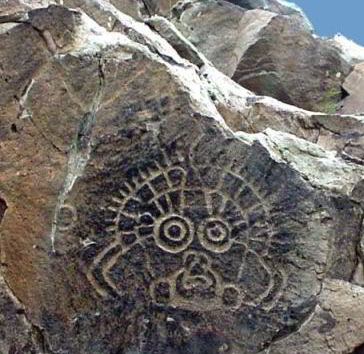
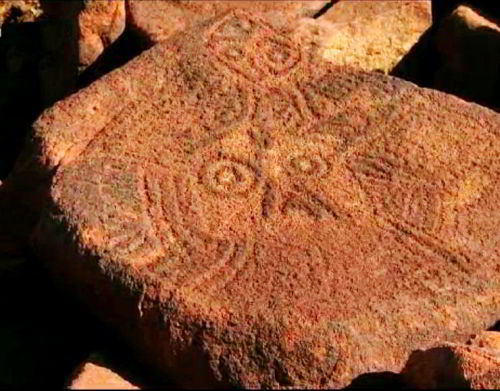
in Chinese Helanshan and Australian Murujuga are well-known.
Other less-known testimonies
are the
records
in the landscape
of
the apparent behaviour of the solar orb.
Some of those records are
located in the middle of urban centres,
for
example: the
Cathedral of Zürich,
whose
orientation stands out in sharp contrast
to the other buildings facing
the river .
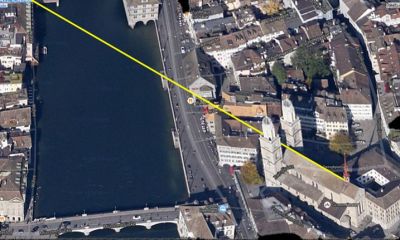
This Cathedral was built in the XIIth century, but not just anywhere...
upon the remains of the Basilica Carolos Magnus ordered to build,
again not just anywhere, …but upon
the remains of a proto-celtic
temple,
fitted with solstitial sunrises and sunsets.
Upon the aerial view of
downtown Zürich are
drawn
the rays of the setting sun,
threading their way
between the two towers
until the Gross Munster's spire.
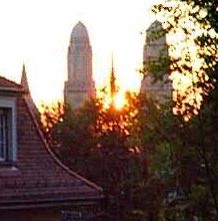
Today, this staging
at dusk on summer solstice
days
is still a worth seeing
event.
In
1963, Michael O'Kelly
discovered that the 19 meters long corridor
at Newgrange was funnelling the
light of the winter solstice sunrise upon
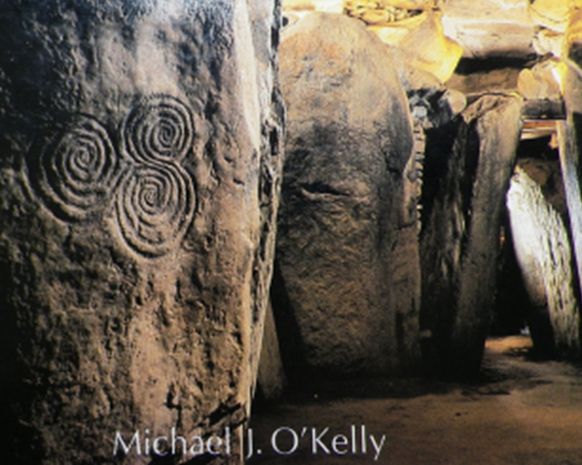
a labyrinthic figure,
the perfect metaphor
of the apparent
cyclicality of
time.
The light come through a separate "Roof-Box" over the entrance,
a kind of Solar trap.
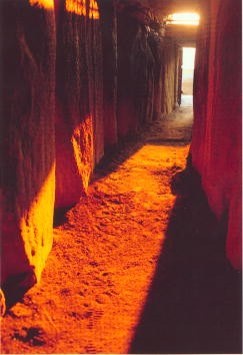
This winter
solstitial solar
lighting
lasts a few seconds
on Dec. 17th,
then grows
up to 3 minutes
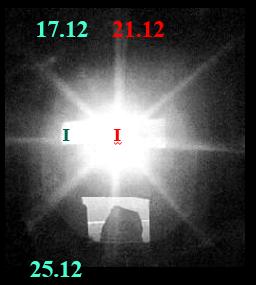
at solar meridional
turnaround on the Dec. 21st,
then diminishes to a few seconds
on Dec. 25th,
and then
dissapears until the next year.
At
Dos Sulif, in Valcamonica,
the rising
summer solstitial Sun casts the shadow of the Plumb-line
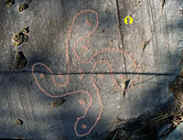
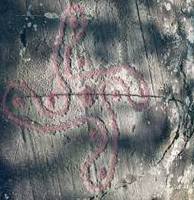
on one axis of the
Camunian roses.
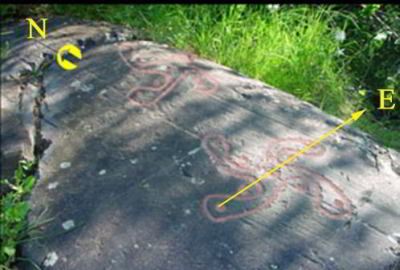
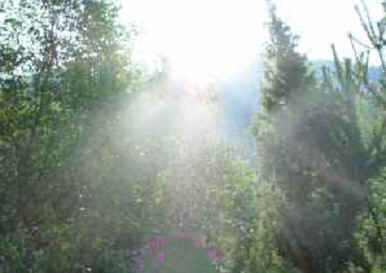
The Sun first appears there very late, at 9:30 am, i.e.: it is
already eastwards.
Seen from La Gardette, in France,
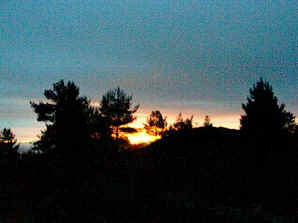
the
winter solstitial Sun rises against the slope of La
Loubière.
The
shadow of the plumb-line falls parallel to the axis of
symmetry
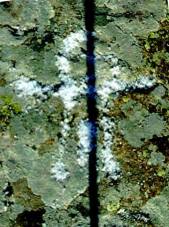
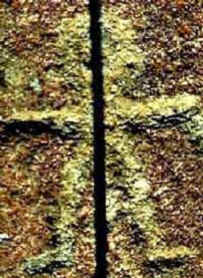
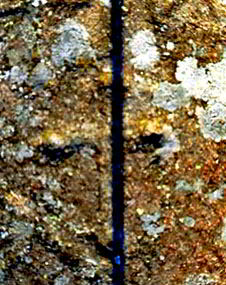
of the grylls, anthropomorphs and cruciforms engraved
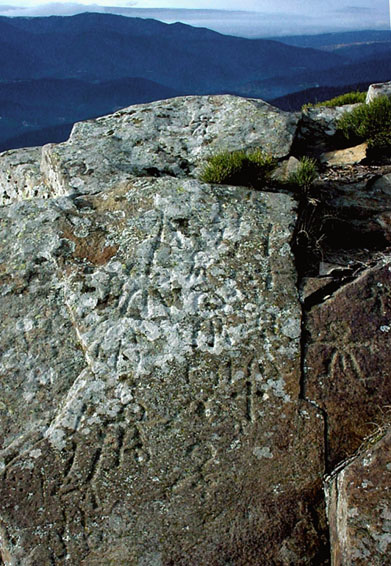
all over this outcrop of weathering
resistant gneiss.
Anton Bouzas discovered that
seen
from
Castriño de Conxo,
at winter solstice,
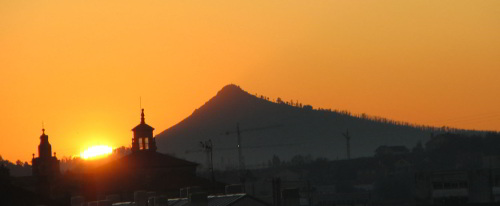
the sun is rising against the slope of
Pico Sacro.
The Rock Art engraving at Conxo looks
more like a sledge than a
labyrinth,
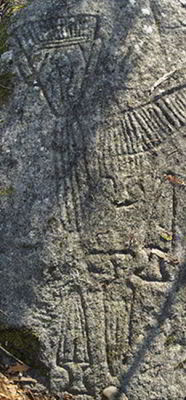
and might well be at the origin of the 9th
century legend
of the
transportation from Pico Sacro to Compostela
of St James' sarcophagus.
Noemi
Méndez & Miguel Angel
Molinero captured
the Colossi of Amenhotep III
as Worshipping Observers of the
winter solstice rising sun.
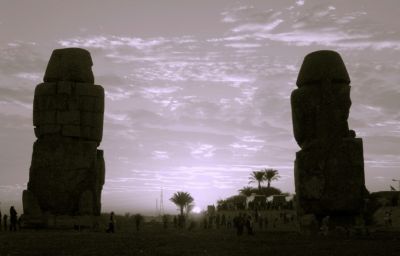
The amount
of labour involved to build such a scenery is tremendous,
the weight of those
colossi is 3000 tons.
Therefore, whenever the landscape caracteristics are
suitable,
other dates than those of solstices might be choosen....
Jose
Luis
Galovart discovered at Mogor,
in Galicia,
that the entrance of the engraved labyrinth is pointing toward
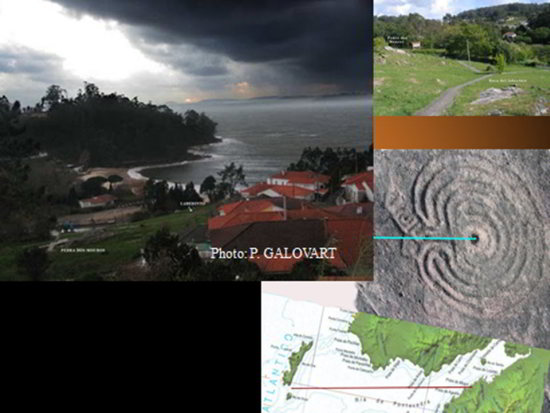
the
Sun setting, 600 hours before vernal equinox.
Mogor is indeed close to Finistere,
the Ends of the Earth and,
before
disappearing into the vast ocean, the Solar Orb sets between two
islets,
Ons
and Onza, located 11 km away.
Off solstitial times and
again about 4
weeks before vernal equinox,
the Egyptologist Marc Gabolde discovered that,

seen from the Small Aten Temple, in Tell el Amarna,
the Sun arises out of an
indentation in the horizon line.
There, it is no longer a matter of capturing the
solsticial Sun,
but of
the inlay into the landscape of a symbol, the sign AKHET.

Here
we have the hieroglyph
of the Sun coiling up two mountains
as drawn by Champollion, which he
translated by Horizon.
The Sphinx head at Giza,
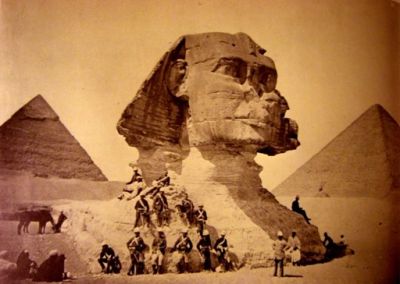
has been carved
out of a rocky outcrop of
hard grey limestone sticking out of the sand,
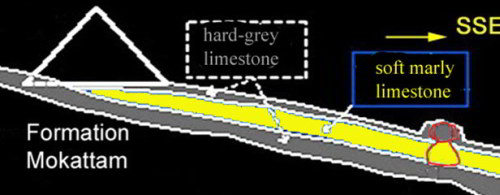
while
the rest, out of soft yellow marly limestone.
In 1980, the Egyptologist Mark Lehner noticed that

"Seen from the
Sphinx at summer solstice,
the setting Sun
is drawing,
between the two large pyramids,
the hieroglyph akhet“.
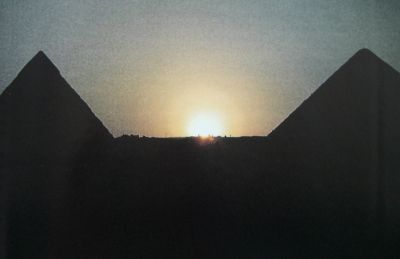
He
called
this staging of the Sun at Giza,
architectural illusionism on the grandest scale.
With
a look at GoogleEarth one has
to admit that the setting
of the pyramids and
the Sphinx is not at all fortuitous.
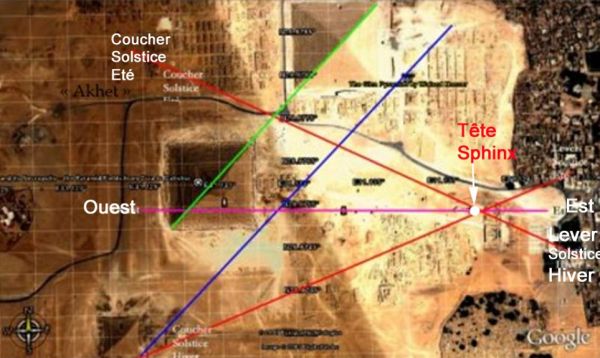
The head of the Sphinx is taken here as the pivot to display
the direction of
the summer solstice setting Sun,
just between the two large pyramids.
It sounds
as if, in order to stage the hieroglyph Akhet,
and in the absence of an
appropriate landscape,
Pharaoh Kheops decided to build it,
and let erect two man-made mountains.
The
astrophysicist Juan Antonio
Belmonte,
the chief of the hispano-egyptian mission,
managed even to involve the Sphinx
into the the show of June 21st,
2006.
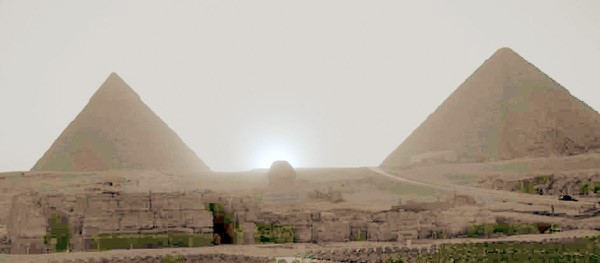
His observations comfort the hypothesis of
a single master building plan at Giza.
230 years earlier, in order to
build the Egyptian State,
the Great architect Imhotep, was for sure badly in
need of a calendar.
Actually, I suspect him to have stage a solsticial show
on
the tropical Island of Elephantine.
There,
the yearly rise of the Nile level,
by a mere geographical
accident,
occurs around summer solstice, just at the time
when the zenital sun lits the
bottom of the Nilometer,
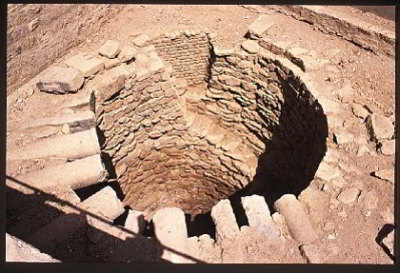
the so called Eratosthene’s well.
The Starvation Stela on the neighbour Island
of Sehel
tells us that Imhotep indeed came over there,
and, the radiodating of
adobe bricks of the Zoser pyramid
by
Georges Bonani, Mark Lehner & al., published in 2001,
indicates, with a fair probability,
year -2741
+/- 74 .
Now, the very controversial question:
WHEN has the Nilotic calendar
been launched ?
Could Imhotep have declare solstice day
July 16th, -2767
first
day of the
Egyptian calendar ?
This day, 1 akhet
I, is the 1st day of the 1st
month
of the season Akhet,

hieroglyph meaning
inundations.
After 7 years of drought,
according to the starvation stela,
Imhotep
launching the Egyptian Calendar by
staging the sun
to lit the bottom of the Nilometer and
letting everybody watch the
Nile level rising again
and soon flooding whole Egypt,
has been for sure a
great show, if it happened!
The
fact is that no amendment to this calendar
has
been brought for 3 millennia…
Thirteen
hundred years later, Amenhotep
IV,
while he was still living in
Thebes with his royal spouse Nefertiti,
witnessed, on May 14th, -1337,
a
partial Solar eclipse of magnitude 94%.
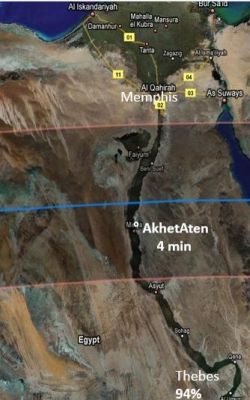
Totality in Thebes would have probably
threaten to death the Pharaoh and his spouse.
Totality actually occurred midway
between Thebes and Memphis.
As engraved on those stele, the Pharaoh disguised
himself as a Sphinx,
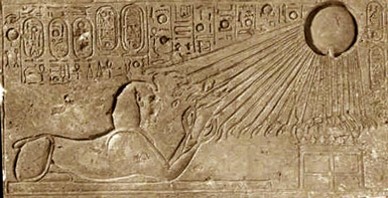
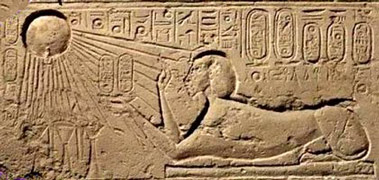
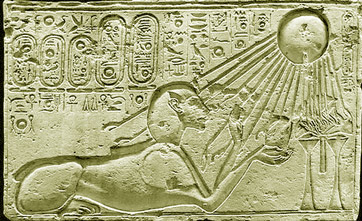
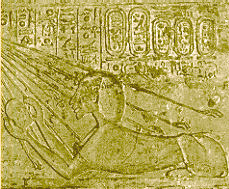
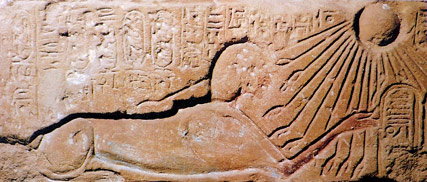
for
the task of decoding the engraved message :
Shall
he build the horizon of Aten in Akhet-Aten.
What have been the
follow-ups
of this injunction of the Solar Disk Aten?
Well, the site of the new
capital Akhet-Aten has indeed
been choosen close to central line of the eclipse.
But that’s not all…
On
the monumental boundary-stela K
at Akhet-Aten
is engraved the date of the founder event of
Akhenaten own cult
of personality.
It is the date of
the
foundation stone ceremony
of the Small Aten Temple:
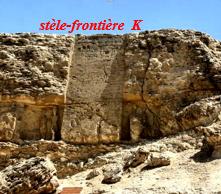
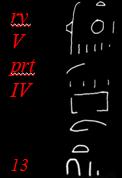
during the 5th regnal year
and peret season,
in its 4th month and in its 13th
day…
here, unfortunately,
one has to read between the lines.
Anyway, if my lecture is correct,
this date, March 2nd,
-1336,
10 lunar months after the
Solar eclipse of May 14th, -1337,
coincides with a day of New Moon,
a day when
the solar disk reigns alone in the sky.
As seen on GoogleEarth aerial view,
this day,
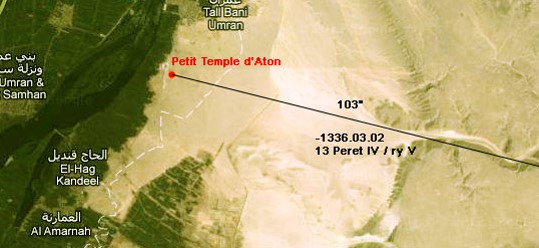
the direction of the rising sun points towards a small valley,
the
royal wadi.
The photo of Marc Gabolde
shows this very same scene,
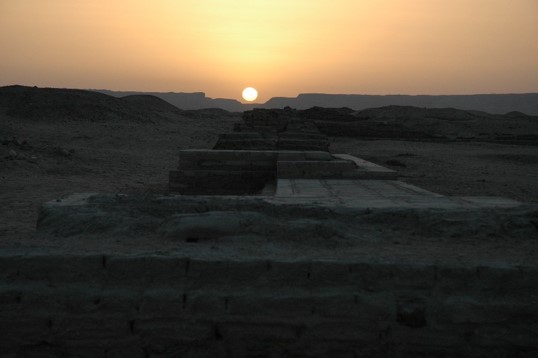
but on February 19th, +2005.
From the Small Temple to Aten,
on March 2nd,
-1336, at 04:38 am UT,
Akhenaton & Nefertiti have
heralded
the
Sun.
This is probably the 1st
event no longer qualifying
for the
label Expression of
non-literate
people.
Note: a tentative
chronology of the amarnian heresy stands
at the end of http://www.archaeometry.org/nefertiti.htm